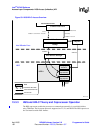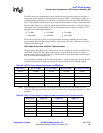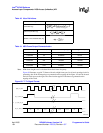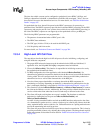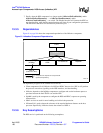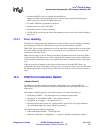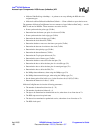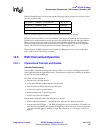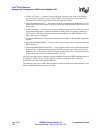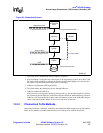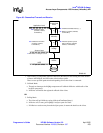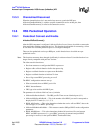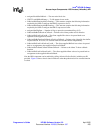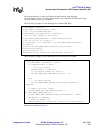
Intel
®
IXP400 Software
Access-Layer Components: HSS-Access (IxHssAcc) API
April 2005 IXP400 Software Version 2.0 Programmer’s Guide
200 Document Number: 252539, Revision: 007
• UINT8 *rxCircular — A pointer to the Rx data pool allocated by the client as described in
previous section. It points to a set of circular buffers to be filled by the received data. This
address will be written to by the NPE and must be a physical address.
• unsigned numRxBytesPerTS — The length of each Rx circular buffer in the Rx data pool. The
buffers need to be deep enough for data to be read by the client before the NPE re-writes over
that memory.
• UINT32 *txPtrList — The address of an area of contiguous memory allocated by the client to
be populated with pointers to data for transmission. Each pointer list contains a pointer per
active channel. The txPtrs will point to data to be transmitted by the NPE. Therefore, they
must point to physical addresses.
• unsigned numTxPtrLists — The number of pointer lists in txPtrList. This number is dependent
on jitter.
• unsigned numTxBytesPerBlk — The size of the Tx data, in bytes, that each pointer within the
PtrList points to.
• IxHssAccChanRxCallback rxCallback — A client function pointer to be called back to handle
the actual tx/rx of channelized data after bytesPerTSTrigger bytes have been received for all
trunk time slots. If this pointer is NULL, it implies that the client will use a polling mechanism
to detect when the tx and rx of channelized data is to occur.
After the client application is connected with the channelized service, the HSS component then can
be enabled by calling ixHssAccChanPortEnable() with the port ID provided to enable the
channelized service from that particular HSS port.
The following figure shows what is done in IxHssAcc when the ixHssAccChanPortConnect() and
ixHssAccChanPortEnable() functions are called.



